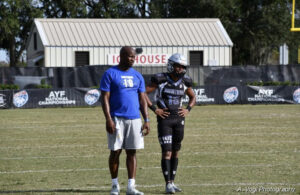Transfer of Power
In our current era of high school football here in Arizona, nothing is surprising.
That’s part of the problem.
Over the past week or so, we’ve seen more players transfer, some just down the street to rival schools.
My issue isn’t necessarily where they transfer to, but, more importantly, when and how.
It’s early June. Winter conditioning and weight training is over. Spring football is over.
“It’s problematic,” one of the head coaches, who spoke off the record, said to the “Zone Read” of players being allowed to transfer so deep into the calendar year.
Some time ago juggling transfer rulings became the AIA’s biggest nightmare and has now escalated to a never-ending migraine because, quite simply, they don’t have the resources to enforce their own rules. It’s up to players, coaches, athletic directors, and parents (gasp!) to play fair.
Some of the issues go much deeper than surface level.
Administrators and athletic directors decide which out of district transfer students they choose to accept and most aren’t overly selective, especially if it’s a standout athlete. Further, the more students in seats, the more revenue each school receives from the federal government. In the midst of our teacher shortage, this is quite telling and, truthfully, not surprising.
Players transferring this late is damaging for other reasons, like taking valuable practice and 7’s reps away from ex-teammates who may have been lower on the depth chart than said transfer. In some instances, players leaving can be two-fold: some locker rooms will become more united, others more divided, with whispers and finger-pointing, at times towards coaches, or even other players, for creating or feeding into the “situation.”
Some daddy ballers claim “hardships” in hopes of attaining immediate eligibility – going so far as threatening to file lawsuits, blaming coaches for “verbal abuse” or “harassment” when it simply came down to their son not being talented enough to crack the top half of the depth chart.
“Zone Read” spoke to multiple head coaches about the topic. One recurring concern was how these late-year transfers have almost become glorified for their decisions, many of which are solely football related.
While not as earth shaking as the college football transfer portal, more and more AZHS players are finding new destinations, some a great distance from their actual home address.
“I don’t know what the solution is,” another head coach noted.
Many feel requiring players to sit the final five regular season games and the entire postseason (if applicable) would deter some from exploring the transfer option. Under current transfer rules, players must sit the first five regular season games their first year with their new program.
Another coach said, colleges and high schools [referring to those here in Arizona], make it too easy.
It’s simply our current football climate, in many ways, overlapping with the every day.
“In life, if you don’t like what’s going on, you just switch teams.”
Even in early June.
Northern Exposure
It all started in Billings, Montana during youth football.
Out of necessity, then 10-year-old Donivan Dixon was moved from wide receiver to quarterback.
“I had to go to quarterback because we didn’t have one,” the Cave Creek Cactus Shadows High freshman said to the “Zone Read” with a chuckle. “That’s pretty much the way it went. I love the position now.”
 The 5-foot-9, 160-pounder with a rocket arm was scheduled to go to Pinnacle High until his father, Chris Dixon, was named the new Cactus Shadows head coach, replacing Mike Hudnutt, who resigned at the end of the school year.
The 5-foot-9, 160-pounder with a rocket arm was scheduled to go to Pinnacle High until his father, Chris Dixon, was named the new Cactus Shadows head coach, replacing Mike Hudnutt, who resigned at the end of the school year.Chris Dixon, currently the Arizona Rattlers’ quarterbacks and running backs coach, won two Indoor Football League Championships as the quarterback of the Sioux Falls Storm.
Now father and son get to spend the next four years together at Cactus Shadows.
“I’ve played for him, essentially my whole life,” Donivan explained. “He let me choose where I wanted to go [to high school] and I wanted to be with him. I’m excited to go with him again. There was really no debate.”
One of my deep throws in bracket play on Sunday pic.twitter.com/FuUKN2Zocb
— Donivan Dixon (@donivandixon15) January 18, 2022
Donivan, who is hoping to step in and win the starting varsity job this summer, already knows his dad won’t play favorites.
“I know how he coaches,” he said. “I know he’s going to be hard on me. He’s not going to hand anything to me. So, I just know I have to work hard if I’m going to get on the field. I think if I put the work in this summer I definitely can [start].”
He patterns his game after one of college football’s elite.
“I definitely look at [Alabama’s] Bryce Young the most,” he explained. “Because he’s not the tallest and I’m not the tallest. He’s also not the biggest. So, he’s definitely motivated me to get to the next level.”
God is great! Truly grateful for everyone who made this possible and for all the support I’ve received. All glory to God! pic.twitter.com/nsFozsuXwI
— Bryce Young (@_bryce_young) December 12, 2021
Dixon, who lives close to campus, said he’s already been throwing with his new CSHS receivers at 5:00AM before practice and weights, as well as getting better acquainted with dad’s playbook ramping up to the start of fall camp.
In a state known for high-level high school quarterbacks, this class of 2026 talent could be the next.
Cactus Shadows opens their season at Desert Edge on September 2nd.
Officially, A Problem
The state of Arizona isn’t just experiencing a water shortage.
Arizona high school football is also in the midst of a game official shortage.
So much so, the AIA is asking schools to reschedule a total of 50 games on six different Fridays this fall, ranging from early September to late October, to either Thursdays or Saturdays to ensure there will be referee crews to officiate the games.
Why has this become an issue?
There are plenty of reasons.
First, is simply growth. There are now close to 300 schools in the AIA (280 this fall to be exact). More schools means more games played and, subsequently, more referees needed to call those games. With the Valley continuing to grow, particularly in the southeast Valley, the need for quality refs will only increase in the coming years.
Another is pay. As in, not enough of it. While I’m certain most game officials love what they do, is the juice worth the squeeze when they’re not only sacrificing Friday evenings, but often the back part of Friday afternoons which stretch well into Friday nights when you consider the travel demands, present day high school games running longer, and other circumstances which can arise.
Being a high school official isn’t a glamorous job, especially when you consider the flack they may receive from coaches, players, and, at times, even parents but they are vitally important, especially as prep football in State 48 continues to be played at an extremely high level.


